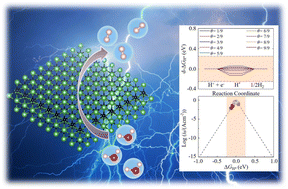A metallic La3C2 monolayer with remarkable activity for the hydrogen evolution reaction: a first-principles study†
Abstract
The key challenge to realizing large-scale hydrogen production via the hydrogen evolution reaction (HER) is the search for efficient and cost-effective catalysts. Lanthanum (La) with unique d/f orbital electron adjustability in compounds and high abundance in the earth's crust could provide a new opportunity to develop HER catalysts. In this work, we focus on designing high-performance catalysts composed of La and C elements through a composition-adjustment strategy. Four conductive La–C monolayers (i.e. La2C, La3C2, La2C3, and LaC2) are identified through swarm-intelligence structure search calculations. For the four stable monolayers, there appears to be a negative correlation between the active site density and orbital occupation of La atoms at the Fermi level, which can be attributed to La coordination numbers and C structural units modulated by the C content. Among them, the Gibbs free energy, H coverage, exchange current density, and active site density of the La3C2 monolayer are superior/comparable to those of commercial Pt, mainly originating from the lower charge-transfer amount from La to C atoms and higher coordination number of La atoms. Moreover, its remarkable HER performance can be maintained independent of H coverage in the individual/average hydrogen evolution process, which can effectively avoid catalyst poisoning caused at high H coverage. All these interesting properties make the La3C2 monolayer a promising catalyst for application in the HER.



 Please wait while we load your content...
Please wait while we load your content...